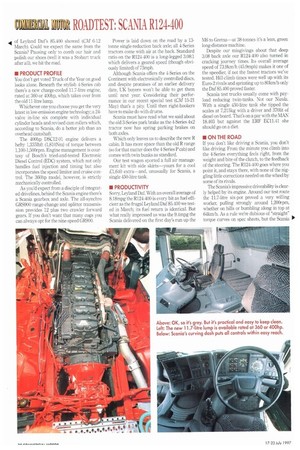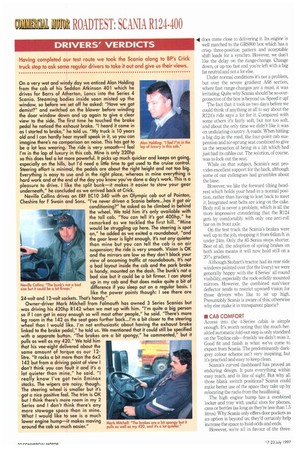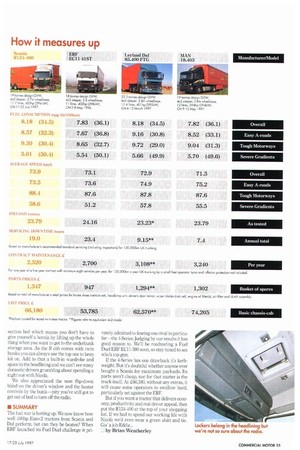0112 ROADTEST: SCANIA R124-400 of Leyland Daf's 85A00 showed (CM
Page 32

Page 34

Page 35

If you've noticed an error in this article please click here to report it so we can fix it.
6-12 March). Could we expect the same from the Scania? Pausing only to comb our hair and polish our shoes (well it was a Stobart truck after all), we hit the road.
You don't get voted Truck of the Year on good looks alone. Beneath the stylish 4-Series cab there's a new charge-cooled 11.7-litre engine, rated at 360 or 400hp, which takes over from the old 11-litre lump.
Whichever one you choose you get the very latest in low-emission engine technology; a 24valve in-line six complete with individual cylinder heads and revised cam rollers which, according to Scania, do a better job than an overhead camshaft.
The 400hp DSC12-01 engine delivers a hefty 1,3351bft (1,810Nm) of torque between 1,100-1,500rpm. Engine management is courtesy of Bosch's tried-and-tested Electronic Diesel Control (EDC) system, which not only handles fuel injection and timing but also incorporates the speed limiter and cruise control. The 360hp model, however, is strictly mechanically controlled.
As you'd expect from a disciple of integrated clrivelines, behind the Scania engine there's a Scania gearbox and axle. The all-synchro GRS900 range-change and splitter transmission provides 12 plus two crawler forward gears. If you don't want that many cogs you can always opt for the nine-speed GR900. Power is laid down on the road by a 13tonne single-reduction back axle; all 4-Series tractors come with air at the back. Standard ratio on the R124-400 is a long-legged 3.08:1 which delivers a geared speed (though obviously limited) of 73mph.
Although Scania offers the 4-Series on the Continent with electronically controlled discs, and despite promises of an earlier delivery date. UK buyers won't be able to get them until next year. Considering their performance in our recent special test (CM 15-21 May) that's a pity. Until then right-hookers have to make do with drums.
Scania must have read what we said about the old 3-Series park brake as the 4-Series 4x2 tractor now has spring parking brakes on both axles.
Which only leaves us to describe the new R cabin. It has more space than the old R range (so for that matter does the 4-Series P cab) and comes with twin bunks as standard.
Our test wagon sported a full air management kit with side skirts—yours for a cool £1,640 extra—and, unusually for Scania, a single 450-litre tank.
Sorry, Leyland Daf. With an overall average of 8.18mpg the R124-400 is every bit as fuel efficient as the frugal Leyland Daf 85.400 we tested in March: its fuel return is identical. But what really impressed us was the 9.4mpg the Scania delivered on the first day's run up the M6 to Gretna—at 38-tonnes it's a lean, green long-distance machine.
Despite our misgivings about that deep 3.08 back axle our R124-400 also turned in cracking journey times. Its overall average speed of 73.9km/h (45.9mph) makes it one of the speedier, if not the fastest tractors we've tested. Hill-climb times were well up with its Euro-2 rivals and sprinting up to 80km/h only the Daf 85.400 proved faster.
Scania test trucks usually come with payload reducing twin-tanks. Not our Nicola. With a single 450-litre tank she tipped the scales at 7,215kg with a driver and 3701it of diesel on board. That's on a par with the MAN 18.403 but against the ERF EC11.41 she should go on a diet.
If you don't like driving a Scania, you don't like driving. From the minute you climb into the 4-Series everything feels right, from the weight and bite of the clutch, to the feedback of the steering. The R124-400 goes where you point it, and stays there, with none of the niggling little corrections needed on the wheel by some of its rivals.
The Scania's impressive driveability is clearly helped by its engine. Around our test route the 11.7-litre six-pot proved a very willing worker, pulling strongly around 1,200rpm, whether on hills or bumbling along in top at 64km/h. As a rule we're dubious of "straight" torque curves on spec sheets, but the Scania does come close to delivering it. Its engine is well matched to the GRS900 box which has a crisp three-position pattern and acceptable shift loads for a synchra However, we don't like the delay on the range-change. Change down, or up too fast and you're left with a big fat neutral and not a lot else.
Under normal conditions it's not a problem, but over the severe gradient A68 section, where fast range-changes are a must, it was irritating. Quite why Scania should be so overprotective of the box is beyond us. Speed it up!
The fact that it took us two days before we could think of anything at all to say about the R124's ride says a lot for it. Compared with some others it's fairly soft, but not too soft, and about the only time we didn't like it was on undulating country A-roads. When hitting a big dip in the road, the four-point cab suspension and air-sprung seat combined to give us the sensation of being in a lift which had just had its cables cut. The solution, of course, was to lock out the seat.
While on that subject, Scania's seat provides excellent support for the back, although some of our colleagues had grumbles about the base.
However, we like the forward tilting headrest which holds your head in a normal position, rather than having to lean back to meet it. Integrated seat belts are icing on the cake. Body roll is never a problem, which is all the more impressive considering that the R124 gets by comfortably with only one anti-roll bar on its front axle.
On the test track the Scania's brakes were well up to the job, stopping it from 64Iun/h in under 24m. Only the 85 Series stops shorter. Best of all, the adoption of spring brakes on both axles means it will now hold still on a 20% gradient.
Although Stobart's tractor had its rear side windows painted over (for the livery) we were generally happy with the 4-Series' all-round visibility, especially the rock-solidly mounted mirrors. However, the combined sun/visor deflector tends to restrict upward vision for those drivers who like to sit up high. Presumably Scania is aware of this; otherwise why else make it in transparent plastic?
Access into the 4-Series cabin is simple enough. It's worth noting that the much heralded automatic fold-out step is only standard on the Topline cab—frankly we didn't miss it. Good fit and finish is what we've come to expect from Scania. The predominantly dark. grey colour scheme isn't very inspiring, but it's practical and easy to keep clean.
Scania's curved dashboard has proved an enduring design. It puts everything within easy reach, and in line of sight. But why all those blank switch positions? Scania could make better use of the space they take up by relocating the radio from the headlining.
The high engine hump has a combined locker and tray with useful slots for phones, cans or bottles (as long as they're less than 1.5 litres). Why Scania only offers door pockets as an option is beyond us; they'd certainly help increase the space to hold odds and ends.
However, we're all in favour of the three section bed which means you don't have to give yourself a hernia by lifting up the whole thing when you want to get to the underbunk storage area, As the R cab comes with twin bunks you can always use the top one to keep kit on, Add to that a built-in wardrobe and space in the headlining and we can't see many domestic drivers grumbling about spending a night out with Nicola.
We also appreciated the neat flip-down blind on the driver's window and the heater controls by the bunk-pity you've still got to get out of bed to turn off the radio.
The fuel war is hotting up. We now know how well 400hp Euro-2 tractors from Scania and Daf perform, but can they be beaten? When ERE launched its Fuel Duel challenge it pri vatelv admitted to fearing one rival in particular-the 4-Series. Judging by our results it has good reason to. We'll be roadtesting a Fuel Duel ERF EC11-380 soon, so stay tuned to see who's top gun.
If the 4-Series has one drawback it's kerbweight. But it's doubtful whether anyone ever bought a Scania for maximum payloads. Its parts aren't cheap, nor for that matter is the truck itself. At £66,180, without any extras, it will cause some operators to swallow hard, particularly set against the ERE But if you want a tractor that delivers economy, productivity and real driver appeal, then put the R124-400 at the top of your shopping list. If we had to spend our working life with Nicola we'd even wear a green shirt and tie. Gis' a job Eddie...
ii by Brian Weatherley




















































































































